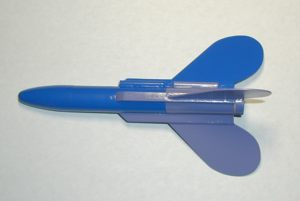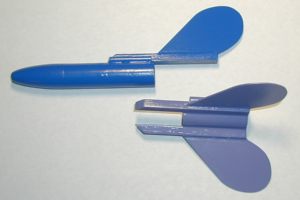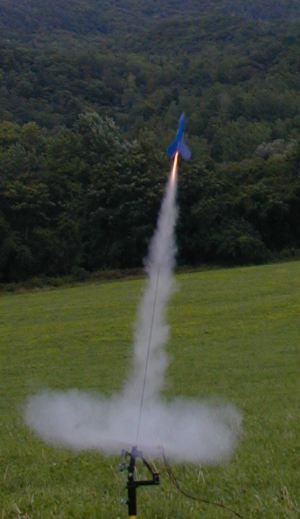![[Picture]](/images/archive/images/ratings/rating_cognis_gnat.gif) (09/10/02) I was at
NARAM 43 in New York and LawnDart Rocketry had a stand there. I was able to see
a number of Cognis kits that Dale was getting ready to sell through LawnDart.
Cognis Aerospace kits are designed in Australia. So after returning home I made
contact with LawnDart to see when these kits would be available. Once available
I order several of them; the
Lunar
Lander, the
Zweistik
Repulsor, and this one: the Gnat.
(09/10/02) I was at
NARAM 43 in New York and LawnDart Rocketry had a stand there. I was able to see
a number of Cognis kits that Dale was getting ready to sell through LawnDart.
Cognis Aerospace kits are designed in Australia. So after returning home I made
contact with LawnDart to see when these kits would be available. Once available
I order several of them; the
Lunar
Lander, the
Zweistik
Repulsor, and this one: the Gnat.
I wanted the unique tumble recovery offered by the Gnat and as listed according to LawnDart's page: "A Simple Rocket! The Gnat uses three methods of recovery in one very small rocket! The model separates in flight so that the pieces are aerodynamically unstable. The upper section, with one fin attached, spins to the ground like a sycamore leaf. The bottom section, holding the spent motor, tumbles back."


The Gnat stands a tad over 7" tall. The main body is based on a 18mm body tube that comes in two pieces. The nose cone is balsa. The longerons are a hard balsa. The fins are 1/16" balsa. It has an 18mm thrust ring and two 1/8" launch lugs.
CONSTRUCTION:
As with the Zweistik Repulsor I received one of the pre-released kits that only came with a single drawing and 3 notes to guide LawnDart in kitting this rocket. That being said, I can not comment on the instructions, however, just as the Repulsor, I will say that this is a very easy kit to build so the instructions need not be anything special.
To build this rocket you need an 18mm motor. I pushed the 18mm motor into the lower (shorter) 18mm body tube until only 1/4" was sticking out. I marked the motor here and at the top. Remove the motor and measure the distance from the top of the motor to the upper mark (~9/16"). Next use a piece of balsa or a stick and apply a ring of glue 1/2" up into the upper body tube (longer). Then insert the thrust ring. Using the motor, push the thrust ring into position until the upper mark on the motor is even with the bottom of the upper tube. Remove the motor and wipe off any excess glue. Set aside to all it to dry fully.
Next put the motor back into the lower body tube and push up until the lower mark is even with the bottom. Then slide this into the upper body tube until it hits the thrust ring. Slide the lower body tube up (if any) until it touches the bottom of the upper tube. Use a small piece of masking tape across the tubes so that they don't spin. Now using an Estes Marking Guide or a guide from any other kit (unless LawnDart's instructions contain one) mark the lower tube for three fins. Use a door jam and extend the lines the full length of both tubes.
Here comes the fun, but a bit tricky part: attaching the longerons. While the tubes are still together (with the motor in place), put glue along one side of a line ONLY on the lower tube. Next place one of the longerons onto this glue and keep it straight and aligned to the line and align the bottom to be even with the lower tube. Be sure not to let glue get up onto the upper tube with the attachment of this longeron. Let dry. Do the same for a second longeron on the lower tube and on the same side of the second line. Let dry. Now, for the third longeron, place glue on the third line, on the same side BUT on the upper tube. Attach the longeron, making sure not to get any glue onto the lower tube. Let dry. Once dry the two pieces should separate easily.
Put the assembly back together with the motor in place. Glue one of the launch lugs to the side of the longeron that is attached to the upper body tube. Put glue on the second launch lug and place the glue-side down onto the lower body tube so that it is touching the same longeron. Be sure NOT to get any glue onto the longeron. You may want to turn the upper tube slightly so that it is now away from the lower (second) launch lug. Let dry.
I had to cut my fins using the picture provided. I cut the pattern from the drawing and then cut the three fins from the 1/16" balsa provided. Once cut, I placed them all together and sanded them to be exactly the same. Then, with the two body tubes together and the motor in place, attach each of the three fins to the center of each of the longerons. The bottom of the root edge should be even with the bottom of the longeron.
The last thing I attached was the nose cone. Apply glue to the inside of the upper body tube and insert the nose cone shoulder.
I used left over paints for finishing this rocket. I used Plasti-Kote Primer, several coats and sanded in between. I then painted the upper section using Krylon Navy Blue paint and lower section using Krylon Light Purple paint.
Overall, for CONSTRUCTION I would rate this kit 4 ½ points. It was easy to build and components were of appropriate quality. I guess, and it varies from rocketeer to rocketeer, that having to cut your own fins is a slight detractor. I didn't mind, but with the rounded edges did make it somewhat of a challenge.
FLIGHT/RECOVERY:
 Cognis (LawnDart) does not have a recommended motor list
(potentially it is now in the instructions) and I did not make this one up in
RockSim, so I simply made the decision to start with an 18mm 1/2A6-2. My
finished weight was 0.5 ounces.
Cognis (LawnDart) does not have a recommended motor list
(potentially it is now in the instructions) and I did not make this one up in
RockSim, so I simply made the decision to start with an 18mm 1/2A6-2. My
finished weight was 0.5 ounces.
The first launch of this rocket gave us a surprise. It came off the pad fine (as see in this picture) but at about 10 feet started to tumble and twist and basically be unstable. On the way down the ejection charge popped and the two pieces separated.
Well, I thought maybe the 1/2A has too much propellent weight toward the rear of the rocket. Probably not the best reasoning, but I decided to test it with an A8-3. Only to have a repeat performance, just more violent and it was actually on the ground before the ejection charge popped.
I brought the rocket home and stuffed 0.3 ounces of clay into the upper tube and pressed it firm against the nose cone (above the thrust ring).
The next day I flew it twice successfully on the 1/2A-2's. The first of these flights kicked the motor upon ejection. The two-fin assembly didn't tumble, rather, it spun like a helicopter. The one-fin assembly didn't "spin to the ground like a sycamore leaf", rather, it flipped and flopped its way down.
The next flight on the 1/2A6-2 also kicked the motor and this time the two-fin assembly did tumble and the one-fin assembly did spin (very fast). It was neat to see.
For FLIGHT/RECOVERY, I would rate this kit 3 ½ points. The fact that it was unstable as built takes a lot away. I'm sure LawnDart will be making some nose weight recommendations going forward. Outside of that, this rocket is nice on 1/2A's for the backyard. Anything larger you will need to have a couple of spotters!
I give the kit an OVERALL rating of 4 points. It was easy to build. It has something a bit different for recovery. It actually has a nice look to it even if it was simply a "pop-the-nose-cone" recovery rocket. After adding nose weight to make it stable, it can be a backyard flyer on 1/2A's, but anything larger you will need to watch out so you don't lose it. All-in-all, a nice little rocket to have in your collection.
Sponsored Ads
 |
 |











